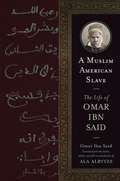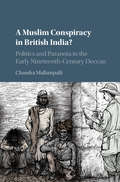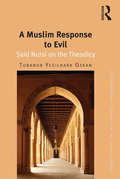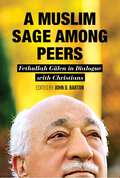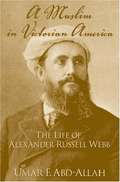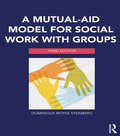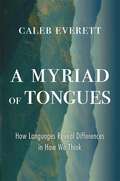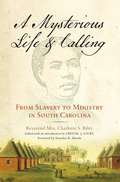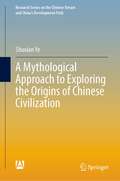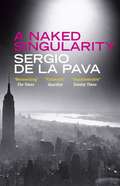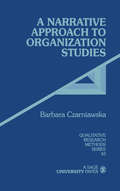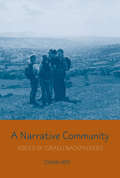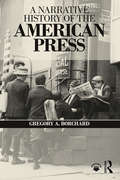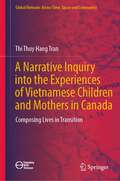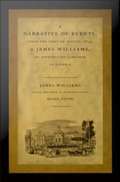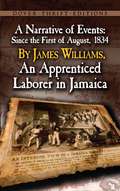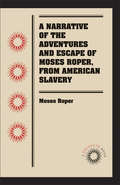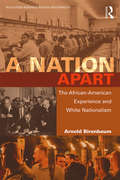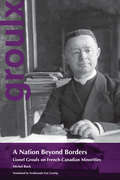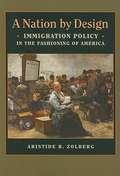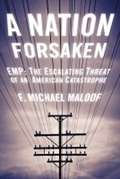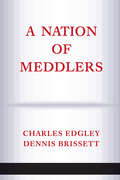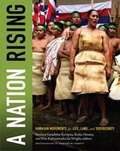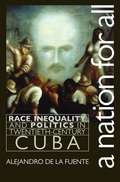- Table View
- List View
A Muslim American Slave
by Alison Liebhafsky Des ForgesBorn to a wealthy family in West Africa around 1770, Omar Ibn Said was abducted and sold into slavery in the United States, where he came to the attention of a prominent North Carolina family after filling “the walls of his room with piteous petitions to be released, all written in the Arabic language,” as one local newspaper reported. Ibn Said soon became a local celebrity, and in 1831 he was asked to write his life story, producing the only known surviving American slave narrative written in Arabic. In A Muslim American Slave, scholar and translator Ala Alryyes offers both a definitive translation and an authoritative edition of this singularly important work, lending new insights into the early history of Islam in America and exploring the multiple, shifting interpretations of Ibn Said’s narrative by the nineteenth-century missionaries, ethnographers, and intellectuals who championed it. This edition presents the English translation on pages facing facsimile pages of Ibn Said’s Arabic narrative, augmented by Alryyes’s comprehensive introduction, contextual essays and historical commentary by leading literary critics and scholars of Islam and the African diaspora, photographs, maps, and other writings by Omar Ibn Said. The result is an invaluable addition to our understanding of writings by enslaved Americans and a timely reminder that “Islam” and “America” are not mutually exclusive terms. This edition presents the English translation on pages facing facsimile pages of Ibn Said’s Arabic narrative, augmented by Alryyes’s comprehensive introduction and by photographs, maps, and other writings by Omar Ibn Said. The volume also includes contextual essays and historical commentary by literary critics and scholars of Islam and the African diaspora: Michael A. Gomez, Allan D. Austin, Robert J. Allison, Sylviane A. Diouf, Ghada Osman, and Camille F. Forbes. The result is an invaluable addition to our understanding of writings by enslaved Americans and a timely reminder that “Islam” and “America” are not mutually exclusive terms.
A Muslim Conspiracy in British India?: Politics and Paranoia in the Early Nineteenth-Century Deccan
by Chandra MallampalliAs the British prepared for war in Afghanistan in 1839, rumours spread of a Muslim conspiracy based in India's Deccan region. Colonial officials were convinced that itinerant preachers of jihad - whom they labelled 'Wahhabis' - were collaborating with Russian and Persian armies and inspiring Muslim princes to revolt. Officials detained and interrogated Muslim travellers, conducted weapons inspections at princely forts, surveyed mosques, and ultimately annexed territories of the accused. Using untapped archival materials, Chandra Mallampalli describes how local intrigues, often having little to do with 'religion', manufactured belief in a global conspiracy against British rule. By skilfully narrating stories of the alleged conspirators, he shows how fears of the dreaded 'Wahhabi' sometimes prompted colonial authorities to act upon thin evidence, while also inspiring Muslim plots against princes not of their liking. At stake were not only questions about Muslim loyalty, but also the very ideals of a liberal empire.
A Muslim Response to Evil: Said Nursi on the Theodicy (Contemporary Thought in the Islamic World)
by Tubanur Yesilhark OzkanWhile Christian approaches to the problem of evil have been much discussed, the issue of theodicy in Islam is relatively neglected. A Muslim Response to Evil explores new insights and viewpoints and discusses possible solutions to theodicy and the problem of evil through the early philosophy and theology ofIslam as well as through a semantic analysis of evil (sharr) in the Qur’Ä n. Reflecting on Said Nursi’s magnum opus, the Risale-i Nur Collection (Epistles of Light), Tubanur Yesilhark Ozkan puts Nursi’s theodicy into discourse with so called ’secular’ theodicy or ’anthropodicy’, supported by scholars such as Newton, Descartes, Leibniz, Spinoza, Hume, and Kant. Her study offers a fascinating new perspective on the problem of evil for scholars of comparative religion, philosophy of religion, and Islamic thought.
A Muslim Sage Among Peers: Fethullah Gulen in Dialogue with Christians
by John D. BartonThis volume puts Fethullah Gulen and the Hizmet movement in dialogue with Christian theologians, philosophers and organizations concerning areas of shared interest. The Christian voices represented in these constructed dialogues are diverse: contemporary and historical, Catholic and Protestant, theological and pragmatic. While all of the essays explore overlaps and similarities between Gulen and these dialogue partners, they also bring to the surface differences and critical assessments. The result is a multi-faceted conversation that invites us all into deeper levels of historical and theological imagination, self-reflection, and collaborative service.
A Muslim in Victorian America: The Life of Alexander Russell Webb
by Umar F. Abd-AllahA biography of Alexander Russell Webb, a central figure of American Islam during the late nineteenth and early twentieth centuries. A native of the Hudson Valley, he was a journalist, editor, and civil servant. Raised a Presbyterian, Webb early on began to cultivate an interest in other religions and became particularly fascinated by Islam. While serving as U.S. consul to the Philippines in 1887, he took a greater interest in the faith and embraced it in 1888, becoming one of the first Americans known to have done so. Within a few years, he began corresponding with important Muslims in India. Webb became an enthusiastic propagator of the faith, founding the first Islamic institution in the United States: the American Mission. He wrote numerous books intended to introduce Islam to Americans, started the first Islamic press in the United States, published a journal entitled the Modern World, and served as the representative of Islam at the 1893 World's Parliament of Religions in Chicago. In 1901, he was appointed Honorary Turkish Consul General in New York and was invited to Turkey, where he received two Ottoman medals of merit. In this first-ever biography of Webb, Umar F. Abd-Allah examines Webb's life and uses it as a window through which to explore the early history of Islam in America. Except for his adopted faith, every aspect of Webb's life was, as Abd-Allah shows, quintessentially characteristic of his place and time. It is because he was so typically American that he was able to serve as Islam's ambassador to America (and vice versa).
A Mutual-Aid Model for Social Work with Groups
by Dominique Moyse SteinbergGroup work is a popular and widely used social work method. Focusing particularly on the central role of mutual aid in effective group work, this text presents the theoretical base, outlines core principles, and introduces the skills for translating those theories and principles into practice. A Mutual-Aid Model for Social Work with Groups will help readers to catalyze the strengths of group members such that they become better problem solvers in all areas of life from the playroom to the boardroom. Increased coverage of evaluation and evidence-based practice speaks to the field's growing concern with monitoring process and assessing progress. The book also includes: worker-based obstacles to mutual aid, their impact, and their antidotes pre-group planning including new discussion on curriculum groups group building by prioritizing certain goals and norms in the new group the significance of time and place on mutual aid and the role of the group worker maintaining mutual aid during so-called individual problem solving an expanded discussion of anti-oppression and anti-oppressive practice unlocking a group's potential to make difference and conflict useful special considerations in working with time-limited, open-ended, and very large groups. Case examples are used throughout to help bridge the gap between theory and practice, and exercises for class or field, help learners to immediately apply conceptual material to their practice. All resources required to carry out the exercises are contained in over 20 appendices at the end of the book. Key points at the end of each chapter recap the major concepts presented, and a roster of recommended reading for each chapter points the reader to further resources on each topic. Designed to support ethical and successful practice, this textbook is an essential addition to the library of any social work student or human service practitioner working with groups.
A Myriad of Tongues: How Languages Reveal Differences in How We Think
by Caleb EverettA sweeping exploration of the relationship between the language we speak and our perception of such fundamentals of experience as time, space, color, and smells.We tend to assume that all languages categorize ideas and objects similarly, reflecting our common human experience. But this isn’t the case. When we look closely, we find that many basic concepts are not universal, and that speakers of different languages literally see and think about the world differently.Caleb Everett takes readers around the globe, explaining what linguistic diversity tells us about human culture, overturning conventional wisdom along the way. For instance, though it may seem that everybody refers to time in spatial terms—in English, for example, we speak of time “passing us by”—speakers of the Amazonian language Tupi Kawahib never do. In fact, Tupi Kawahib has no word for “time” at all. And while it has long been understood that languages categorize colors based on those that speakers regularly encounter, evidence suggests that the color words we have at our disposal affect how we discriminate colors themselves: a rose may not appear as rosy by any other name. What’s more, the terms available to us even determine the range of smells we can identify. European languages tend to have just a few abstract odor words, like “floral” or “stinky,” whereas Indigenous languages often have well over a dozen.Why do some cultures talk anthropocentrically about things being to one’s “left” or “right,” while others use geocentric words like “east” and “west”? What is the connection between what we eat and the sounds we make? A Myriad of Tongues answers these and other questions, yielding profound insights into the fundamentals of human communication and experience.
A Mysterious Life and Calling
by Charlotte S. Riley Crystal J. Lucky Joycelyn K. MoodyA rare discovery, A Mysterious Life and Calling is the autobiography of Charlotte Levy Riley, who was born into slavery but after emancipation achieved a fulfilling career as a preacher in the South Carolina Conference of the African Methodist Episcopal Church, schoolteacher, and civil servant. Although several nineteenth-century accounts by black preaching women in the northern states are known, this is the first memoir by a black woman preaching in the South, both before and after the Civil War, to be discovered. Born in 1839, Charlotte Riley recounts her unusual experiences growing up as a young slave girl in Charleston under the protection of her parents and the dominion of her wealthy owners. She was taught to read, write, and sew, despite laws forbidding black literacy, and while still a slave married a free black architect. Raised a Presbyterian, she writes in her memoir of her conversion at age fourteen to the African Methodist Episcopal (AME) church, embracing its ecstatic worship and led by her own spiritual visions. After the war, she separated permanently from her husband, who objected to her call to preach, and despite poor health pursued a career into the early twentieth century as a licensed minister of the AME church, a powerful preacher at multiracial revivals, and a school teacher and principal. She contributed to the civic development of South Carolina in the post-Reconstruction era and early twentieth century, including appointment in 1885 as postmistress of Lincolnville, an all-black incorporated town in South Carolina. She published her autobiography around 1902. Crystal J. Lucky discovered Riley's forgotten book in the archives of the Stokes Library at the historically black Wilberforce University in Ohio. She provides an introduction and notes to the narrative, explaining Riley's references to contemporaries, events, society, and religious practice throughout her childhood and the turbulent years of the Civil War and Reconstruction. Lucky also places A Mysterious Life and Calling in the context of other spiritual autobiographies and slave narratives.
A Mythological Approach to Exploring the Origins of Chinese Civilization (Research Series on the Chinese Dream and China’s Development Path)
by Shuxian YeIs the lion the symbol of China? Or should it be the dragon or the phoenix? This book makes a provocative interpretation of the Chinese ancient totems such as the bear and the owl. Taking a mythological approach, it explores the origin of Chinese civilization using the quadruple evidence method, which integrates ancient and unearthed literature, oral transmission, and archeological objects and graphs.It testifies to the authenticity of unresolved ancient myths and legends from the origins of Chinese Jade Ware (6200BC-5400 BC) to the names of the Yellow Emperor (2698–2598 BC) and the legends from the Xia (2010BC-1600BC), Shang (1600BC-046BC), Zhou (1046BC-771BC), and Qin (221BC-206BC) Dynasties. The book lays the foundation for a reconstruction of Chinese Mythistory. With well over 200 photographs of historic artifacts, the book appeals to both researchers and general readers.
A Naked Singularity
by Sergio De La PavaNOW A MAJOR FILM STARRING JOHN BOYEGA, OLIVIA COOKE AND BILL SKARSGÅRD"The Wire written by Voltaire" Sunday Times"Crime and Punishment as reimagined by the Coen Brothers" The MillionsCasi is a hotshot public defender working on the front line of America's War on Drugs. So far he's on the winning side. He's never lost a case. But nothing lasts forever, and pride like his has a long way to fall. Funny, smart and always surprising, A Naked Singularity speaks a language all of its own and reads like nothing else ever written. Casi's beautiful mind and planetary intelligence make him an inimitable and unforgettable narrator. In De La Pava's hands, the labyrinthine miseries of the New York Justice System are as layered and diabolical as Dante's nine circles of Hell. But the Devil doesn't hog the best lines. There are plenty here to go around.
A Narrative Approach to Organization Studies
by Barbara CzarniawskaFrom setting up the fieldwork to writing up the research, this volume takes readers through the narrative approach to qualitative research with a focus on organization studies. Inspired by the work of Bakhtin, Eco, Rorty and Silverman, the author demonstrates that narratives are still the main carriers of knowledge in all societies.
A Narrative Community: Voices of Israeli Backpackers
by Chaim NoyAn intertextual examination of the storytelling of Israeli backpackers that analyzes their unique patterns of communication to create a thorough picture of this "narrative community."
A Narrative History of the American Press
by Gregory A. BorchardBeginning with the American Revolution and spanning over two hundred years of American journalism, A Narrative History of the American Press provides an overview of the events, institutions, and people who have shaped the press, from the creation of the First Amendment to today. Gregory A. Borchard’s introductory text helps readers develop an understanding of the role of the press in both the U.S. and world history, and how American culture has shaped—and been shaped by—the role of journalism in everyday life. The text, along with a rich array of supplemental materials available online, provides students with the tools used by both reporters and historians to understand the present through the past, allowing readers to use the history of journalism as a lens for implementing their own storytelling, reporting, and critical analysis skills.
A Narrative Inquiry into the Experiences of Vietnamese Children and Mothers in Canada: Composing Lives in Transition (Global Vietnam: Across Time, Space and Community)
by Thi Thuy TranThis book recounts the understanding of three Vietnamese children and their mothers’ experiences as they navigate being newcomers to Canada. It explores the cultural, traditional, familial, intergenerational, personal, social, institutional, political, historical, community, and linguistic narratives shaping Vietnamese children and mothers as they compose their lives. The author employs narrative inquiry as a methodological approach, beginning by positioning herself through her narrative beginnings, delving deep into philosophical and methodological underpinnings. The author lays out the three child–mother pairs’ experiences as they negotiated a new culture in Canada, particularly the spaces of home, schools, and communities. The book brings a holistic and relational way of understanding familial curriculum-making as support for children’s school curriculum-making and for the ways in which Vietnamese families’ sustain their ongoing life making. It also looks at the influence of the homeland’s language, culture, and educational traditions. Through the complex interplay between the children and mothers’ narratives and the writer’s own stories, this book discusses multiperspectival and multidimensional ways of supporting Vietnamese newcomers and other ‘arrivals’ composing their lives in similar landscapes. The book is relevant to educators, researchers, cultural brokers, and policymakers, opening avenues for understanding cultural ethics within the relational ethics of narrative inquiry, as well as familial narratives in relation to institutional and social narratives.
A Narrative of Events, since the First of August, 1834, by James Williams, an Apprenticed Labourer in Jamaica
by James WilliamsThis book brings back into print, for the first time since the 1830s, a text that was central to the transatlantic campaign to fully abolish slavery in Britain's colonies. James Williams, an eighteen-year-old Jamaican "apprentice" (former slave), came to Britain in 1837 at the instigation of the abolitionist Joseph Sturge. The Narrative he produced there, one of very few autobiographical texts by Caribbean slaves or former slaves, became one of the most powerful abolitionist tools for effecting the immediate end to the system of apprenticeship that had replaced slavery. Describing the hard working conditions on plantations and the harsh treatment of apprentices unjustly incarcerated, Williams argues that apprenticeship actually worsened the conditions of Jamaican ex-slaves: former owners, no longer legally permitted to directly punish their workers, used the Jamaican legal system as a punitive lever against them. Williams's story documents the collaboration of local magistrates in this practice, wherein apprentices were routinely jailed and beaten for both real and imaginary infractions of the apprenticeship regulations. In addition to the complete text of Williams's original Narrative, this fully annotated edition includes nineteenth-century responses to the controversy from the British and Jamaican press, as well as extensive testimony from the Commission of Enquiry that heard evidence regarding the Narrative's claims. These fascinating and revealing documents constitute the largest extant body of direct testimony by Caribbean slaves or apprentices.
A Narrative of Events: Since the First of August, 1834, by James Williams, an Apprenticed Laborer in Jamaica (Dover Thrift Editions)
by James WilliamsA teenaged slave-turned-apprentice in nineteenth-century Jamaica recorded his experiences in the British apprenticeship system in this book, which constitutes one of the only autobiographical texts by a Caribbean slave. While working as a laborer at a pimento plantation in the St. Ann parish, James Williams suffered flogging, imprisonment, and other punishments. His narrative reveals the ugly truth behind the apprenticeship system that developed after the outlaw of the British slave trade, which he deems even crueler than the former system of slavery.Written in 1837, James Williams' narrative was an effective tool for abolitionists who sought to end the apprenticeship system. This edition of his historic memoir also contains the entire testimony from the Commission of Inquiry, sponsored by the Colonial Office, which validated the truth of Williams' account.
A Narrative of the Adventures and Escape of Moses Roper, from American Slavery
by Moses RoperThe Narrative of the Adventures and Escape of Moses Roper can be read as an extended autobiographical meditation on the meaning of race in antebellum America. First published in England, the text documents the life of Moses Roper, beginning with his birth in North Carolina and chronicling his travels through South Carolina, Georgia, and Florida. Roper was able to obtain employment on a schooner named The Fox, and in 1834 he made his way to freedom aboard the vessel. Once in Boston, he was quickly recruited as a signatory to the constitution of the American Anti-Slavery Society (AASS), but he sailed to England the next year. Roper's narrative is especially interesting because although it was published after Frederick Douglass's much-heralded 1845 Narrative, Roper actually preceded Douglass in his involvement in AASS as well as in his travel to the United Kingdom. This text is often cited by literary scholars because of its length, its extensive detail, and its unforgiving portrayal of enslaved life in the "land of the free." A DOCSOUTH BOOK. This collaboration between UNC Press and the University of North Carolina at Chapel Hill Library brings selected classic works from the digital library of Documenting the American South back into print. DocSouth Books uses the latest digital technologies to make these works available as downloadable e-books or print-on-demand publications. DocSouth Books are unaltered from the original publication, providing affordable and easily accessible editions to a new generation of scholars, students, and general readers.
A Nation Apart: The African-American Experience and White Nationalism (Routledge Research in Race and Ethnicity)
by Arnold BirenbaumThis book examines the ongoing struggle for social justice by and for African Americans. Examining the persistent rolling back of civil and voting rights for this population and other minorities since the end of Reconstruction, the author discusses the continued colonization of African Americans and the rise of white nationalism before considering what can be done to create a democratic version of Americanism. With discussions on the possibilities that exist for eliminating health disparities, increasing income and reducing wealth inequality, enhancing the urban environment and housing stability, reforming criminal justice, and reconsidering the case for reparations for the descendants of slaves, the author considers whether white nationalism is a threat to Democratic Americanism and if the declining fortunes of working class Americans can be reversed by means of a "Marshall Plan" for the United States. A study of the sustained racial injustices of American society over the last century and a half and their possible remedies, A Nation Apart will appeal to all those with interests in race and ethnicity and questions of social justice.
A Nation Beyond Borders: Lionel Groulx on French-Canadian Minorities (Biographies et mémoires)
by Michel BockThis book, first published as Quand la nation débordait les frontières (Hurtubise HMH, 2004), is considered the most comprehensive analysis of Lionel Groulx's work and vision as an intellectual leader of a nationalist school that extended well beyond the borders of Québec. Recipient of the 2005 Governor General's Literary Award in non-fiction, the original French edition also won the Michel-Brunet Award (Institut d'histoire de l'Amérique française), the Prix Champlain (Conseil de la vie française en Amérique), and a medal awarded by the Québec National Assembly. It was also shortlisted for the Jean-Charles-Falardeau Award (Fédération canadienne des sciences humaines du Canada) and the City of Ottawa Book Award. For over five decades, historians and intellectuals have defined the nationalist discourse primarily in territorial terms. In this regard, Groulx has been portrayed—more often than not—as the architect of Québécois nationalism. Translated by Ferdinanda Van Gennip, A Nation Beyond Borders will continue to spark debate on Groulx's description of the parameters of the French-Canadian nation. Highlighting the often neglected role of French-Canadian minorities in his thought, this book presents the Canon as an uncompromising advocate of solidarity between all French-Canadian communities.
A Nation By Design: Immigration Policy In The Fashioning Of America
by Aristide R. ZolbergAccording to the national mythology, the United States has long opened its doors to people from across the globe, providing a port in a storm and opportunity for any who seek it. Yet the history of immigration to the United States is far different. Even before the xenophobic reaction against European and Asian immigrants in the late nineteenth century, social and economic interest groups worked to manipulate immigration policy to serve their needs. In A Nation by Design, Aristide Zolberg explores American immigration policy from the colonial period to the present, discussing how it has been used as a tool of nation building. <p><p> A Nation by Design argues that the engineering of immigration policy has been prevalent since early American history. However, it has gone largely unnoticed since it took place primarily on the local and state levels, owing to constitutional limits on federal power during the slavery era. Zolberg profiles the vacillating currents of opinion on immigration throughout American history, examining separately the roles played by business interests, labor unions, ethnic lobbies, and nativist ideologues in shaping policy. He then examines how three different types of migration--legal migration, illegal migration to fill low-wage jobs, and asylum-seeking--are shaping contemporary arguments over immigration to the United States. <p> A Nation by Design is a thorough, authoritative account of American immigration history and the political and social factors that brought it about. With rich detail and impeccable scholarship, Zolberg's book shows how America has struggled to shape the immigration process to construct the kind of population it desires.
A Nation Forsaken: The Escalating Threat of an American Catastrophe
by Michael MaloofThere have been warnings from scientists and other experts for years that the Nation's electrical grid system and other critical infrastructures that have almost complete dependency on electricity and electronic components are highly vulnerable to an electromagnetic pulse (EMP) event either from natural or man-made causes. However, Congress and the administrations of previous and current presidents largely have ignored those warnings. Events such as the September 11, 2001, terrorist attack on the United States and then the devastating Hurricane Katrina that revealed vulnerabilities to those infrastructures heightened that concern. Due to the lapse of time and a relatively calm period since those disasters, policymakers have been lulled back into complacency rather than take preventative action against what could be the biggest threat to US national and economic security in our lifetime. The threat from an EMP attack on our critical infrastructures either from an impending solar storm of serious intensity - expected between 2012 and 2014 - or a high-altitude nuclear explosion are threats that could have long-term catastrophic consequences for our society and our way of life. In 2008 a congressional commission studied the consequences of an EMP attack not only the power grid itself but also the consequences to every sector of our economy: telecommunications, banking, transportation, food, manufacturing, construction, and energy. While these critical infrastructures continue to face such an impending crisis, Congress has basically ignored its own commission report and instead has treated the threat of an EMP event as a political football to be punted whenever expedient for their own gain. To date, still nothing has been done to protect the nation. Michael Maloof breaks down that threat in his book A Nation Forsaken. He even outlines how our own military is similarly vulnerable to an EMP event due to its 99 percent dependency on the nation's electrical grid system for electricity and communications, raising the high prospect that it may not be able to function to defend the nation in its time of greatest need. While an EMP event on our civilian infrastructure could be serious, it can be managed if government at the federal, state, and local levels gives a high priority to undertake preventative action to lessen its impact to recover from such an event. Now is the time for Congress to act and stop forsaking our nation.
A Nation In Denial: The Truth About Homelessness
by Alice S. BaumThis book presents a comprehensive review of the scientific evidence that up to 85 percent of all homeless adults suffer the ravages of substance abuse and mental illness, resulting in the social isolation that has been the hallmark of homelessness in the United States since colonial days. .
A Nation Of Meddlers
by Charles EdgleyWe have become a nation of informers and professional meddlers. From social action and concerned citizen groups to psychiatrists and government bureaucrats, there is always someone watching. This book gets to the heart of Americas most visible obsession.. Meddling in the lives of others is now the republics most visible obsession; Americans are meddling into each others lives as never before. Working within the symbolic interactionist tradition of cultural analysis and criticism, Charles Edgley and Dennis Brissett analyze this emergent phenomenon with insightful and provocative descriptions about how we came to be this way, why meddling is so appealing, and how meddling is packaged and marketed. }There was a time when the phrase Its none of your business meant something. Not anymore. A boorish and persistent army of meddlers, equipped with righteous indignation and a formidable array of theories and technologies, has made almost everyones business its own. Meddling in the lives of others is now the republics most visible obsession. From national crusades against bad habits such as drinking, smoking, and gambling to the efforts of a group in Woodbury, Minnesota, to create a fragrance-free work environment, Americans are meddling into each others lives as never before. Often masquerading as social concern or community involvement, the contemporary meddlers intervene in the name of most everything: health, safety, the commonweal, God, and for the sake of the children.Working within the symbolic interactionist tradition of cultural analysis and criticism, Charles Edgley and Dennis Brissett analyze this emergent phenomenon with insightful and provocative descriptions about how we came to be this way, why meddling is so appealing, and how meddling is packaged and marketed. Their conclusion offers wise and sometimes witty cautions about the proper relationship between the individual and society. }
A Nation Rising: Hawaiian Movements for Life, Land, and Sovereignty
by Erin Kahunawaika'ala Kahunawaika’ala Wright Noelani Goodyear-Ka’opua Ikaika HusseyA Nation Rising chronicles the political struggles and grassroots initiatives collectively known as the Hawaiian sovereignty movement. Scholars, community organizers, journalists, and filmmakers contribute essays that explore Native Hawaiian resistance and resurgence from the 1970s to the early 2010s. Photographs and vignettes about particular activists further bring Hawaiian social movements to life. The stories and analyses of efforts to protect land and natural resources, resist community dispossession, and advance claims for sovereignty and self-determination reveal the diverse objectives and strategies, as well as the inevitable tensions, of the broad-tent sovereignty movement. The collection explores the Hawaiian political ethic of ea, which both includes and exceeds dominant notions of state-based sovereignty. A Nation Rising raises issues that resonate far beyond the Hawaiian archipelago, issues such as Indigenous cultural revitalization, environmental justice, and demilitarization.Contributors. Noa Emmett Aluli, Ibrahim G. Aoudé, Kekuni Blaisdell, Joan Conrow, Noelani Goodyear-Ka'opua, Edward W. Greevy, Ulla Hasager, Pauahi Ho'okano, Micky Huihui, Ikaika Hussey, Manu Ka'iama, Le'a Malia Kanehe, J. Kehaulani Kauanui, Anne Keala Kelly, Jacqueline Lasky, Davianna Pomaika'i McGregor, Nalani Minton, Kalamaoka'aina Niheu, Katrina-Ann R. Kapa'anaokalaokeola Nakoa Oliveira, Jonathan Kamakawiwo'ole Osorio, Leon No'eau Peralto, Kekailoa Perry, Puhipau, Noenoe K. Silva, D. Kapua'ala Sproat, Ty P. Kawika Tengan, Mehana Blaich Vaughan, Kuhio Vogeler, Erin Kahunawaika'ala Wright
A Nation for All: Race, Inequality, and Politics in Twentieth-Century Cuba
by Alejandro de la FuenteAfter thirty years of anticolonial struggle against Spain and four years of military occupation by the United States, Cuba formally became an independent republic in 1902. The nationalist coalition that fought for Cuba's freedom, a movement in which blacks and mulattoes were well represented, had envisioned an egalitarian and inclusive country--a nation for all, as Jose Marti described it. But did the Cuban republic, and later the Cuban revolution, live up to these expectations?Tracing the formation and reformulation of nationalist ideologies, government policies, and different forms of social and political mobilization in republican and postrevolutionary Cuba, Alejandro de la Fuente explores the opportunities and limitations that Afro-Cubans experienced in such areas as job access, education, and political representation. Challenging assumptions of both underlying racism and racial democracy, he contends that racism and antiracism coexisted within Cuban nationalism and, in turn, Cuban society. This coexistence has persisted to this day, despite significant efforts by the revolutionary government to improve the lot of the poor and build a nation that was truly for all.
